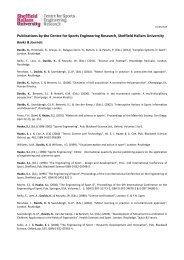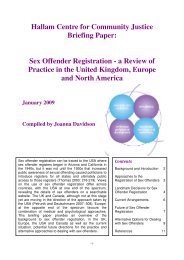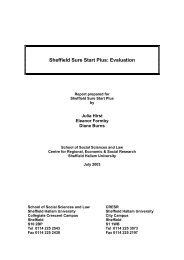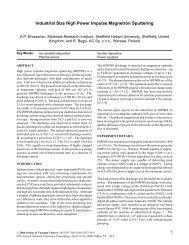The exercise of judicial discretion in rent arrears cases - Sheffield ...
The exercise of judicial discretion in rent arrears cases - Sheffield ...
The exercise of judicial discretion in rent arrears cases - Sheffield ...
Create successful ePaper yourself
Turn your PDF publications into a flip-book with our unique Google optimized e-Paper software.
In November 2001, the Legal Services Commission announced the selection <strong>of</strong> 13 schemes<br />
for pilot fund<strong>in</strong>g (5 <strong>of</strong> these were new schemes, the rema<strong>in</strong><strong>in</strong>g already exist<strong>in</strong>g). Evaluation<br />
<strong>of</strong> these pilots (Myers Wilson, 2004) showed that the vast majority <strong>of</strong> those assisted were<br />
eligible for Legal Help. It also concluded (p. 46) that “broadly speak<strong>in</strong>g the Duty Schemes<br />
were successful <strong>in</strong> secur<strong>in</strong>g a positive outcome for most clients, and <strong>of</strong>ten for landlords as<br />
well.”<br />
Criticisms<br />
<strong>The</strong> procedure for hous<strong>in</strong>g possession <strong>cases</strong> has not been without criticism. In his F<strong>in</strong>al<br />
Report on Access to Justice, Lord Woolf said (Chap 16, para. 20):<br />
“It is generally agreed that the present procedure for possession <strong>of</strong> tenanted property<br />
on grounds <strong>of</strong> <strong>arrears</strong> is unsatisfactory.”<br />
<strong>The</strong> particular concerns outl<strong>in</strong>ed above were echoed by the Law Commission (2002, para.<br />
12.34):<br />
“<strong>The</strong>re have been concerns that suspended possession orders for <strong>rent</strong> have been<br />
too readily given out, made <strong>in</strong> hear<strong>in</strong>gs listed <strong>in</strong> bulk for only a matter <strong>of</strong> m<strong>in</strong>utes<br />
each, with very low attendance rates and poor participation by occupiers. It also<br />
appears illogical to focus the statutory regulation on a hear<strong>in</strong>g which produces only a<br />
suspended order, with very little statutory regulation <strong>of</strong> the process for deal<strong>in</strong>g with<br />
the breach <strong>of</strong> the order which then leads to the actual eviction.”<br />
<strong>The</strong> <strong>in</strong>cidence <strong>of</strong> <strong>rent</strong> <strong>arrears</strong><br />
<strong>The</strong> study is concerned with the use <strong>of</strong> legal proceed<strong>in</strong>gs to deal with tenants <strong>of</strong> local<br />
authorities and hous<strong>in</strong>g associations who have <strong>rent</strong> <strong>arrears</strong>, and here we discuss the policy<br />
background. A number <strong>of</strong> studies have exam<strong>in</strong>ed why tenants <strong>of</strong> social landlords get <strong>in</strong>to<br />
<strong>arrears</strong> and the s<strong>in</strong>gle most significant underly<strong>in</strong>g factor is poverty. Tenants <strong>of</strong> social<br />
landlords are less likely to be <strong>in</strong> work than the average and have a lower gross weekly<br />
<strong>in</strong>come (ODPM, 2004). Households <strong>in</strong> <strong>arrears</strong> are characterised by lack <strong>of</strong> work or low paid<br />
work, comb<strong>in</strong>ed with wider debt problems (Pawson et al, 2005, Ford and Seavers, 1998,<br />
Gray et al, 1994). In Pawson et al’s recent study (2005) landlords po<strong>in</strong>ted to the grow<strong>in</strong>g<br />
vulnerability <strong>of</strong> tenants <strong>in</strong> what has become an <strong>in</strong>creas<strong>in</strong>gly residualised sector. Thus those<br />
suffer<strong>in</strong>g from mental ill-health were particularly liable to accumulate <strong>arrears</strong>.<br />
Although research <strong>in</strong>to <strong>arrears</strong> has generally characterised those <strong>in</strong> <strong>arrears</strong> as either “can’t<br />
payers” or “won’t payers” (see e.g. Ford and Seavers, 1998), Pawson et al, suggest that a<br />
more recent factor is chang<strong>in</strong>g attitudes to household debt, which while <strong>in</strong>creas<strong>in</strong>g debt<br />
generally also made tenants less averse to <strong>in</strong>curr<strong>in</strong>g <strong>arrears</strong>.<br />
12
















